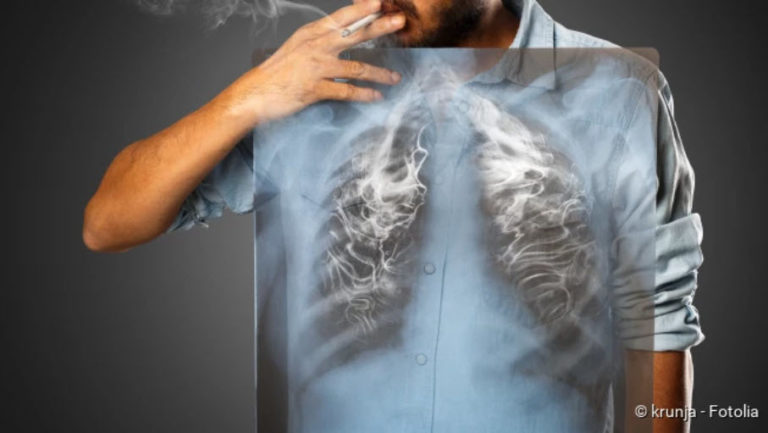Gastroenteritis: causes, treatment, course
Gastroenteritis: causes, treatment, course
Gastroenteritis is the colloquial term for a gastroenteritis caused by pathogens. But the gastro-intestinal flu has nothing to do with the real flu (influenza). It is usually harmless, but causes unpleasant symptoms such as diarrhoea with vomiting. In rare cases, a gastrointestinal infection can be more complicated. Here you will learn the most important facts about the gastro-enteritis.

Gastroenteritis: Description
In medical terminology, gastroenteritis is also generally referred to as an inflammation of the gastrointestinal tract. Strictly speaking, such gastro-intestinal inflammation does not have to be caused exclusively by an infection with pathogens such as viruses or bacteria, but can also be the result of cancer treatment, for example. However, the term “gastroenteritis” usually refers to the infectious (contagious) form.
The colloquial term “gastroenteritis” is somewhat misleading because infectious gastroenteritis is caused by different pathogens than the classical flu (influenza) and there is no connection between these diseases.
After all, you can get a stomach flu at any age. However, it particularly often affects babies and small children. During the first three years of life, children suffer from a gastrointestinal infection on average once or twice a year. Three-quarters of all sick children are between six and 24 months old. The likelihood of contracting gastroenteritis is also increasing again among older people.
What happens with the stomach flu?
A gastro-intestinal flu is the result of an infection with certain pathogens that attack the mucous membrane in the gastro-intestinal tract. These germs, mostly viruses or bacteria, first enter the stomach by absorption through the mouth and then move on through the intestines, where they multiply before being excreted with the faeces. The symptoms of the gastro-enteritis usually correspond to this “migration” through the digestive tract: symptoms in the initial phase are usually nausea and vomiting. They are later replaced by diarrhoea.
What causes diarrhea with vomiting?
When pathogens damage the stomach lining (either directly or via toxins produced), this can trigger a nausea in the brain. Vomiting is a protective reflex of the body, which in this way tries to transport the unwanted intruders out of the body again.
The often severe diarrhoea in a gastrointestinal infection, on the other hand, is caused by the impairment of the mucosal cells in the small and large intestine. Basically, the different pathogens lead to diarrhoea in different ways. Three different mechanisms can be distinguished. Often it is the combination of these mechanisms that causes diarrhoea in the case of gastro-enteritis:
- Secretory diarrhoea
- Exudative diarrhoea
- Osmotic diarrhoea
Some pathogens, such as cholera bacteria, trigger increased water excretion (secretion) in the mucous membrane cells of the intestine into the interior of the intestine. The food pulp there becomes very fluid (secretory diarrhoea).
Other gastroenteritis pathogens cause a severe inflammation of the mucous membrane, which subsequently secretes increased amounts of mucus and occasionally even blood (exudative diarrhoea).
In addition, the food is no longer digested properly because many food components can no longer be absorbed by the broken mucosal cells. Through a physical process known as osmosis, these undigested components draw water into the intestine from the surrounding tissue, which in turn leads to or increases diarrhoea (osmotic diarrhoea).
At what point do you start talking about diarrhea?
More than three bowel movements a day and a very soft to watery stool consistency are indications of diarrhoea. However, the normal stool habits of a person must be taken into account as a comparison. If, for example, someone has a bowel movement only every one or two days and suddenly has to go to the toilet twice a day and excretes thin stool, then this is also diarrhoea.
Diarrhoea can have many causes. In addition to gastro-enteritis, for example, chronic inflammatory intestinal diseases can also be behind it.
Gastroenteritis: infection through contact with faeces and vomit
The route of infection in a gastrointestinal infection is usually faecal-oral. This means that the pathogens from the feces (or vomit) of one person who has the stomach flu get into the mouth of another person in some way. This can happen, for example, if the patient does not wash his hands sufficiently after using the toilet. The pathogens can then find their way from the hands into food or onto objects and thus be absorbed by a healthy person. This path of infection is also called contact or smear infection.
Certain pathogens of a gastro-intestinal flu, so-called noroviruses, can also spread aerogenically, i.e. they can travel from person to person by air and thus transmit a gastro-intestinal flu. This explains, among other things, the enormous risk of infection with noroviruses. The viruses float enclosed in tiny droplets which the patient releases into the ambient air when speaking, coughing or sneezing. They can be inhaled by other people. This transmission path is also known as droplet infection.
Some gastrointestinal influenza pathogens, such as EHEC (Enterohaemorrhagic Escherichia coli) or salmonella, can also be transmitted from animals to humans. Infection occurs mainly via contaminated animal products such as raw eggs (for example in the form of tiramisu or mayonnaise) or milk. Frequently, insufficient cooling of the food contributes to infection with gastro-enteritis pathogens.
How great is the risk of infection with the stomach flu?
How contagious a stomach flu is depends primarily on the pathogen that causes it. The risk of infection increases, for example, if the germs are relatively robust and can survive outside the human body for a long time. In the case of other pathogens, contact with even the smallest amounts is enough to trigger a gastro-enteritis flu, because they multiply particularly quickly and strongly (like noroviruses). If the pathogens are more sensitive or can only cause a disease in larger numbers, the risk of infection is lower.
In general, gastrointestinal infections have a high contagious potential, which is why often several family members fall ill with it or why there are more frequent major outbreaks in community facilities. The more viruses the patient excretes, the more infectious he is. Therefore, the risk of a “gastrointestinal infection” is particularly high as long as the typical diarrhoea with vomiting is present. But even a few days before and after a stomach flu is infectious.
Gastroenteritis: Duration
You can find out everything about the duration of the stomach flu and how long it is contagious under stomach flu – duration.
Gastroenteritis: Symptoms
You can read more about the symptoms of gastroenteritis and possible complications in the article Gastroenteritis – Symptoms.
Gastroenteritis: Causes and risk factors
The term “gastroenteritis” generally refers to a clinical picture in which an infection with a pathogen leads to typical symptoms in the gastrointestinal tract. Depending on the pathogen, incubation time, intensity and duration of the disease vary. The incubation period is the period from infection to the onset of the first symptoms.
In most cases, viruses are behind gastroenteritis, especially noroviruses and rotaviruses, less frequently other viruses such as astro- or sapoviruses. In addition, there is also a whole range of bacteria and some parasites that can cause a gastrointestinal infection.
Rotaviruses
Rotaviruses are very often responsible for gastroenteritis in children. Up to 70 percent of infectious diarrhoea in young children is caused by rotaviruses. In developing countries they are also partly responsible for the high child mortality rate.
During the first years of life, more and more antibodies are produced by the body through more frequent contact with rotaviruses, which protect against later infections or make them weaker. This is why rotaviruses cause gastrointestinal infections in adults less often than in children. However, since there are different types of rotavirus, the body can never be completely immune to them. For example, rotaviruses can also be responsible for travel diarrhoea. In this case, the gastro-enteric flu develops because the person affected has not yet formed antibodies against the rotaviruses that are widespread in the country of travel.
Noroviruses
Noroviruses are even more infectious than rotaviruses. They also occur in countless variations, so that the immune system is usually unable to counteract an infection with effective antibodies. Noroviruses are, among other things, the main pathogens responsible for gastroenteritis in adults and account for about half of all cases of non-bacterial gastroenteritis in this age group. Since noroviruses are also transmitted via the airways (aerogenic) as droplet infections, entire families often suffer from gastroenteritis. In hospitals and nursing homes, affected patients are immediately isolated and doctors and nursing staff wear protective clothing to prevent the spread of the disease.
In the case of an infection with noro- or rotaviruses, the symptoms set in after about ten hours at the earliest and after three days at the latest – depending on the type and quantity of virus.
Salmonella
Salmonella is one of the best known bacteria that can cause gastroenteritis. The gastroenteritis caused by it is also called salmonellosis. The genus Salmonella can be divided into further subgroups, whereby only the salmonella species “Salmonella Enteritidis” causes a classical gastroenteritis. Other types of salmonella, however, cause typhoid or paratyphoid fever. These two diseases can also be accompanied by diarrhoea, but they are serious general diseases and not the typical gastrointestinal infection.
Although salmonellosis can also be transmitted by infected persons, animal products such as raw eggs or insufficiently heated meat are usually the source of infection. Caution is especially important with poultry products. Since salmonella are not killed by freezing, they can also be found in the thawing water of poultry products, for example, and can cause gastroenteritis if consumed. For this reason, you should always drain off the condensation water and, if possible, do not place frozen foods in warm water for defrosting, as salmonella multiplies particularly well in it. However, a certain minimum amount of salmonella must be ingested in order to be infected.
Campylobacter
Bacteria of the genus Campylobacter can also cause gastroenteritis. In the vast majority of cases it is Campylobacter jejuni, sometimes Campylobacter coli. These pathogens are transmitted through contact with animals and the consumption of contaminated food (poultry, raw milk). Campylobacter enteritis is the most common food-borne cause of gastroenteritis, even before salmonellosis. Symptoms appear about two to five days after infection.
Escherichia coli (E. coli)
Most representatives of this bacterial species are completely harmless and even very useful for humans. “Coli” is the genitive of colon, the Latin word for colon. This is exactly where trillions of these bacteria settle in every human and support digestion. However, there are also some E. coli strains that are human pathogenic, i.e. they cause diseases in humans. These include, for example, toxin-producing E. coli (“enterotoxin-producing E. coli”, ETEC for short). In about 40 percent of cases of travel diarrhoea, ETEC is the responsible pathogen. Other harmful strains are EPEC (enteropathogenic E. coli), EIEC (enteroinvasive E. coli), EAEC (enteroaggregative E. coli) and EHEC (enterohaemorrhagic E. coli).
EHEC last came to public attention in spring 2011 in the European Union, when several people died of the so-called hemolytic-uremic syndrome (HUS). This is a disease of the small blood vessels, which in these cases occurred as a complication of a particularly aggressive EHEC infection. In principle, however, EHEC disease rarely leads to HUS.
EHEC and other E. coli strains are transmitted via faecal-oral routes on the one hand and via animal products such as raw meat or unpasteurised milk on the other hand, similar to salmonella. The incubation period is about two to ten days.
Shigellen
Shigellae cause bacterial dysentery, also called shigellosis. This form of gastroenteritis is particularly prevalent when hygiene standards are low, for example in war zones or developing countries. Infection usually occurs via infected water and food. In the United States, shigellosis is rather rare and if it does occur, it is usually brought back as a souvenir from holidays in countries like India, Tunisia or Egypt. The incubation period is between one and four days.
Clostridium difficile
Clostridium difficile is a bacterial species that ultimately occurs everywhere, including in soil and dust. To a certain extent, these bacteria are also found naturally in the human intestine. But if they get the upper hand there, they can trigger a stomach flu. This can happen, for example, when antibiotics are taken if they disturb the microbiotic balance in the gastrointestinal tract. Under certain circumstances the Clostridium difficile bacteria then multiply too much and cause gastroenteritis. However, this is not the classic gastroenteritis, but a severe inflammation of the intestine. Especially feared is the severe course of this intestinal inflammation, which is also called “pseudomembranous colitis”.
Yersinia and cholera bacteria
Yersinia bacteria are rather rare in Western Europe and only responsible for about one percent of all diarrheal diseases. Cholera caused by Vibrio cholerae is also a rarity in western countries, but there are more than six million cases worldwide every year. Although only 15 percent of those infected show symptoms, cholera can be very dangerous in severe cases and with poor medical care. Due to the sometimes massive diarrhoea (“rice water chair”) affected persons, especially children, lose a lot of fluid in a short time.
Food poisoning
Some bacteria indirectly damage the mucous membrane cells of the gastrointestinal tract by producing special toxins. The bacteria Staphylococcus aureus, Bacillus cereus and Clostridium perfringens, for example, belong to such toxin producers. These pathogens can occur in large numbers in spoiled food and, when present in a certain quantity, can cause the symptoms of severe gastroenteritis after only a few hours.
Parasites
Besides viruses and bacteria, there are also certain parasites that can cause gastroenteritis. For example, the amoeba species Entamoeba histolytica is the cause of amoebic dysentery. This disease occurs mainly in tropical and subtropical areas. A common parasitic pathogen that causes diarrhoea in particular is the unicellular organism Giardia lamblia.
Risk factors
In general, gastro-enteritis pathogens always have it easier when the immune system is weakened. This is generally the case with children and older people. Therefore, these age groups are particularly susceptible to gastroenteritis. They also have a greater risk of a more complicated course. The same applies to people who have an immunodeficiency for other reasons, such as AIDS patients and patients receiving chemotherapy or immunosuppressive (immunosuppressive) drugs.
Gastroenteritis: examinations and diagnosis
The right person to contact in the event of gastroenteritis is your family doctor. A typical gastro-enteritis usually proceeds in an uncomplicated manner and can be quickly recognised by the doctor on the basis of the symptoms. However, the exact questioning of the patient about the origin of the disease is essential in order to differentiate gastro-enteritis with certainty from other diseases with similar symptoms (food intolerances, autoimmune diseases, appendicitis, etc.). It is also important to take the patient’s medical history (anamnesis) in order to detect a possibly more complicated course of the gastroenteritis at an early stage. In order for the physician to correctly classify a gastrointestinal infection, the physician asks the following questions, for example:
- Besides vomiting, do you have diarrhoea?
- How long have the complaints existed?
- Do you suspect a connection with a certain food?
- Have you eaten raw milk, uncooked meat or products with raw eggs?
- Are other people in the immediate vicinity (workplace, school, family) affected by gastroenteritis?
- Do you have a fever?
- Did you notice blood in the stool?
- Have you been abroad in the last days or weeks?
- Are you taking medication or have you recently taken any (e.g. antibiotics)?
The doctor also asks the patient about other, already known diseases. In the case of gastro-enteritis in children, the question of a recent change in diet also makes sense.
This is followed by a physical examination: the doctor pays particular attention to signs that indicate a lack of fluid (dehydration), such as dry mucous membranes, sunken eyes or standing skin folds. Especially with small children and infants it is very important to notice and treat a lack of fluid in time.
In most cases, the medical history already indicates that an uncomplicated gastro-enteritis is present. Further examinations can then usually be dispensed with. However, if some of the above questions, such as blood in the stool or a stay abroad, are answered in the affirmative, an attempt is made to determine the pathogen precisely. In this way, the therapy can be specifically adapted. Typical methods for pathogen detection are stool cultures (for bacteria), examinations with the light microscope (for amoebae and cholera bacteria) and the detection of the genetic material of pathogens (for viruses). In certain cases, the patient’s blood and urine are also examined. If necessary, an ultrasound examination or endoscopy (colonoscopy) may also be used to assess the extent of gastroenteritis.
Gastroenteritis: treatment
Drink a lot
What to do in case of stomach flu? This question arises after the diagnosis is made. The answer is usually very simple: Drink as much as possible! This is because the first priority is to compensate for the loss of fluid caused by vomiting and diarrhoea. In the case of a simple gastrointestinal infection, this means in concrete terms drinking lots of unsweetened tea or water (preferably still). Pure juices or lemonade are rather unsuitable, because the high sugar content causes additional problems for the already irritated gastrointestinal tract.
The body also loses salts (electrolytes) with the liquid. A severe electrolyte deficiency can be life-threatening, especially for children. In the pharmacy you can get electrolyte powders that will remedy the electrolyte deficiency. They are especially useful for children with severe diarrhoea and vomiting.
Light meal
Electrolyte powders are usually not necessary if the affected person manages to eat small amounts of food. Although it is often difficult to keep anything at all without vomiting during the acute phase of a stomach flu, the body still needs a little food.
On the one hand, electrolytes lost through food can be reabsorbed, on the other hand, the intestine obtains the building blocks for healing the damaged mucous membrane directly from food. For this reason, those affected by gastroenteritis should try to eat easily digestible food within a few hours of the onset of symptoms. In the acute phase, a soup broth, for example, is well tolerated, but in the further course of the disease, bread, noodles, rice dishes, oat or semolina porridge as well as salt sticks are also tolerated. Too heavy, fatty food should be avoided.
Oral rehydration solutions (ORL)
Doctors also use so-called oral rehydration solutions (ORL), a special dextrose-salt mixture with an ideally balanced sugar and electrolyte content. It is usually taken by mouth (orally). If a severe fluid deficiency already exists, similar preparations can also be administered directly via a venous access as an infusion. Since the 1970s, ORLs have been used as standard worldwide for the treatment of gastroenteritis and other diarrhoeal diseases, which has significantly reduced child mortality in crisis countries in particular.
Drug therapy
In the case of uncomplicated gastroenteritis, no medication is usually used, especially since there is no specific medication against the viral pathogens. Under certain circumstances, however, drug therapy is useful. For example, antibiotics can shorten the duration of the illness in the case of a proven bacterially caused gastro-enteritis. In principle, however, antibiotics are used very cautiously in the case of a gastrointestinal infection and only in the following cases:
- For premature babies
- In the first trimester of pregnancy
- For people with known immunodeficiency
- For severe disease progression
- When bloody diarrhea occurs
- In the detection of pathogens such as Salmonella typhi, Vibrio cholerae, amoebae and Clostridium difficile
The use of antibiotics can be dangerous in EHEC infections because, although they destroy large numbers of enterohaemorrhagic E. coli, their decomposition products may cause haemolytic-uremic syndrome (HUS). Antibiotics should therefore be used with caution for EHEC infections.
In addition to antibiotics, there are other drugs to alleviate the symptoms of gastroenteritis: these include antiemetics that help against nausea and so-called motility inhibitors (for example loperamide), which slow down intestinal movement and thus diarrhoea. The active ingredient Racecadotril can also be used against severe diarrhoea. The spasmolytic butylscopolamine is effective against cramp-like abdominal pain. However, all these drugs are not always useful in every case, which is why the attending physician must decide on their use individually.
Gastroenteritis: Home remedy
To find out which home remedies can help against gastro-enteritis, please refer to gastro-enteritis: Home remedies
Gastroenteritis: Prevention
Hygiene
The only way to prevent gastro-enteritis is to avoid close contact with the sick and to ensure thorough hygiene. This includes above all thorough and regular hand washing. Especially the faeces and vomit of people with gastroenteritis are highly infectious. That is why the toilet is the place where infection is most likely to occur, even if it is also used by those who are ill. The toilet should be cleaned and disinfected before each use. After each visit to the toilet, you should wash your hands with soap for two to three minutes. This can significantly reduce the risk of infection with gastro-enteritis.
However, close physical contact with patients should be avoided as much as possible. In addition, the bed linen and clothing of sick persons should be washed at a minimum of 60°C, better at 90°C.
Stay at home
Anyone who has already noticed signs of a stomach flu should under no circumstances go to school or to work. This is the only way to prevent the disease from spreading further, especially when highly infectious viruses are responsible for the gastroenteritis.
Vaccinations
Active immunisation against rotaviruses is now recommended as standard in infancy from the sixth week of life (oral vaccination). Although such a vaccination cannot guarantee 100% immunity, it has been shown to reduce the number of infections.
There is also a vaccine against the travel sickness cholera, but it is not recommended for normal tourism. Specific recommendations on the destination country can be given by a doctor as part of a medical travel consultation.
Prevention of gastroenteritis when travelling
Otherwise, travel-related gastrointestinal infections can be avoided by following the advice: “Cook it, peel it or leave it”. Thus, in countries with dubious hygiene standards, one should always boil water before use or sterilize it with special tablets or use only original sealed water bottles. One should also avoid raw and insufficiently heated food such as seafood, fish and half cooked meat. In unfavourable cases, ice cubes and ice cream also harbour pathogens of a gastro-enteric flu.
Gastroenteritis: course of disease and prognosis
Depending on the causative pathogen and the general physical condition of the person affected, the symptoms of gastroenteritis can last only a few days or even longer. For example, a norovirus infection usually lasts several days, and acute food poisoning can sometimes be completely overcome within 24 hours. In contrast, amoebic dysentery, for example, can last for weeks if left untreated.
As a rule, however, an acute stomach flu passes away just as quickly as it came. It generally subsides after a short time and heals without consequences. Caution is required in special situations, however: For example, babies and infants can lose a lot of fluid and electrolytes due to severe diarrhoea. In extreme cases, this results in a life-threatening condition due to the gastro-enteritis. Pregnancy and breastfeeding are also situations in which close medical care of mother and child is necessary in order to be able to react in time to possible complications.
A gastro-enteritis is in the majority of cases an unpleasant but rather harmless disease. Complications can often be prevented by the correct symptomatic treatment. A visit to a doctor is recommended in any case, as only a doctor can determine with certainty how severe the gastro-enteritis is and what measures are necessary.





